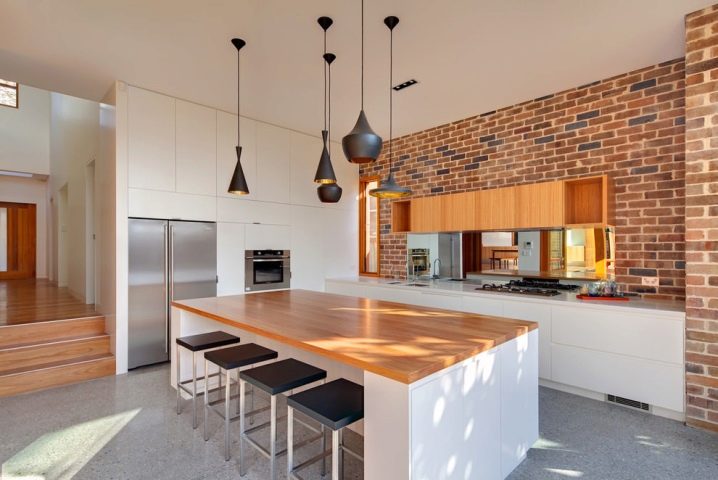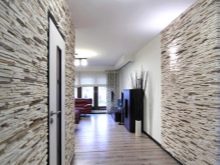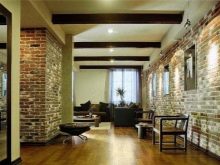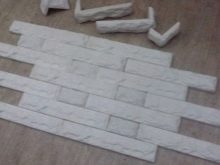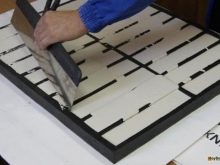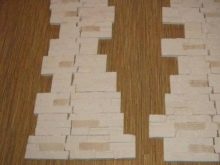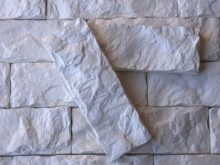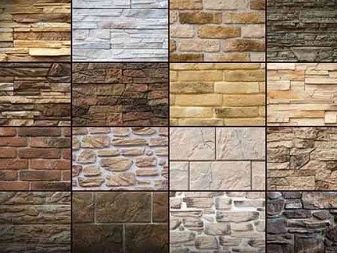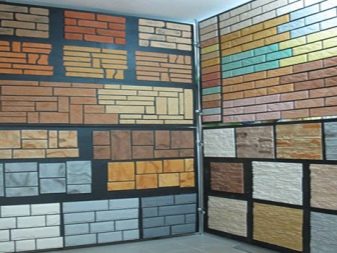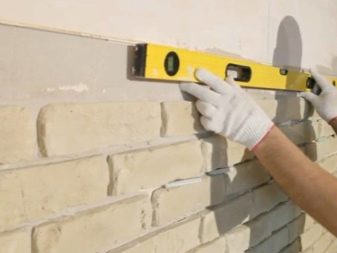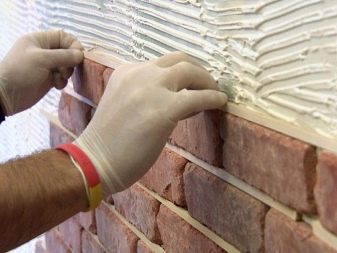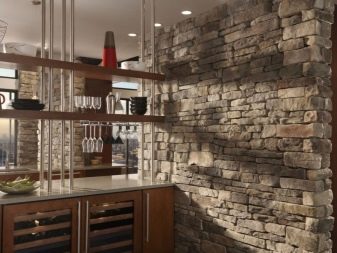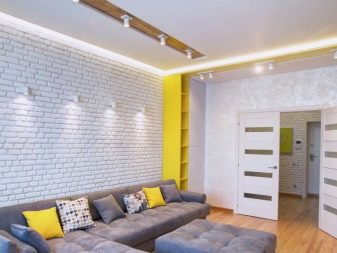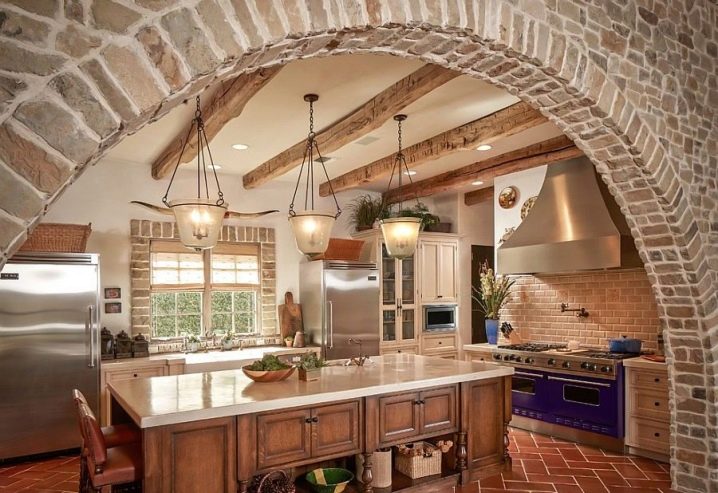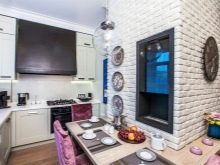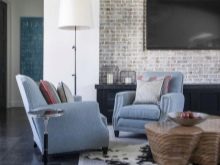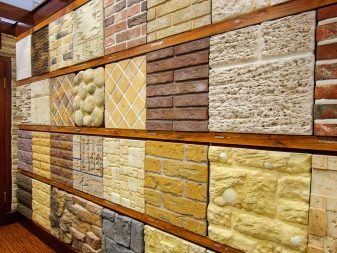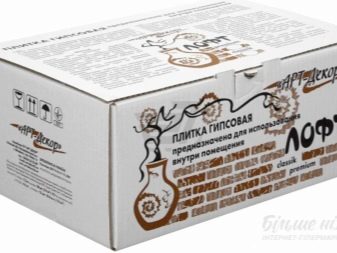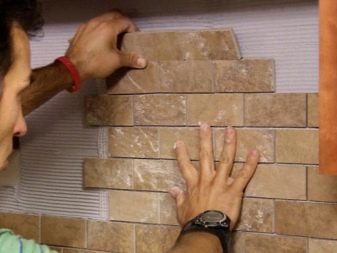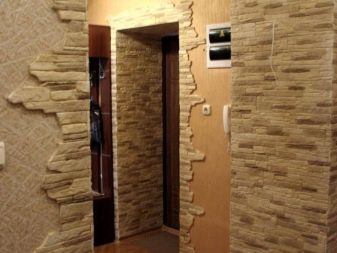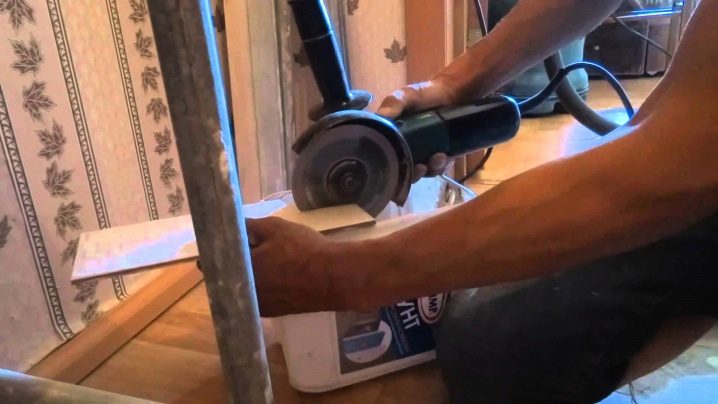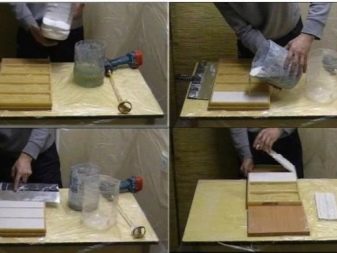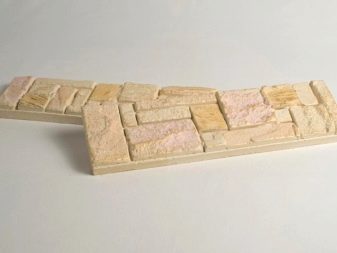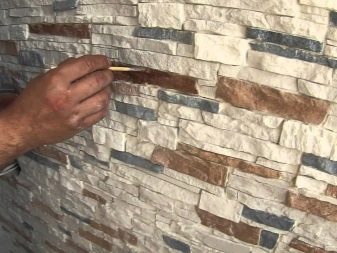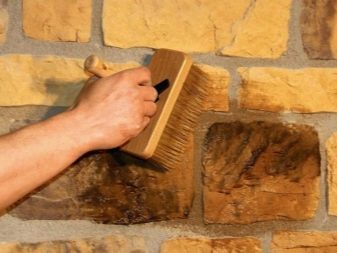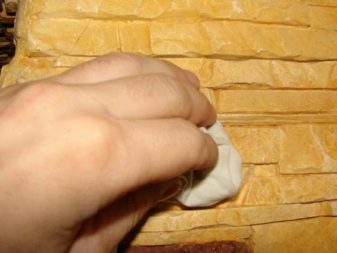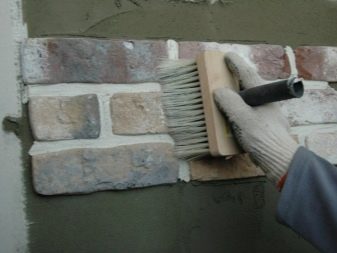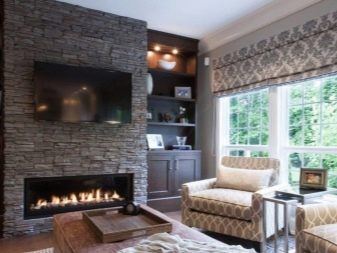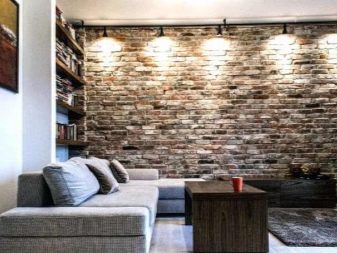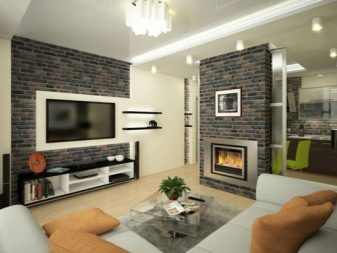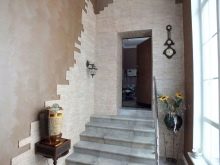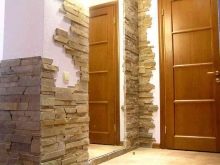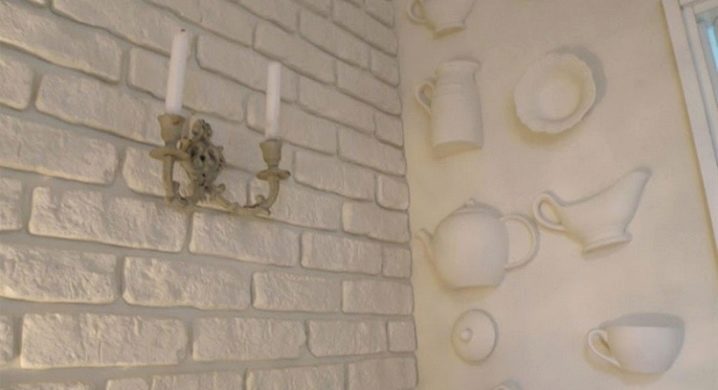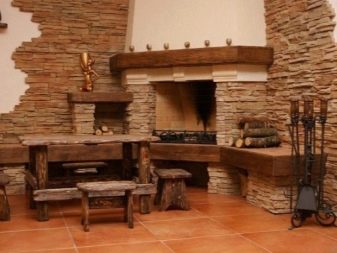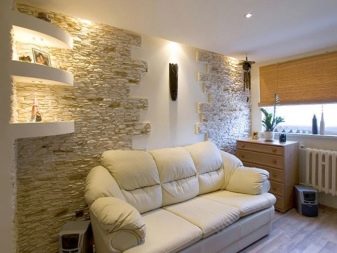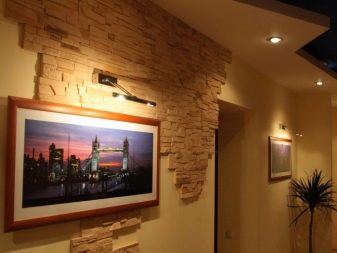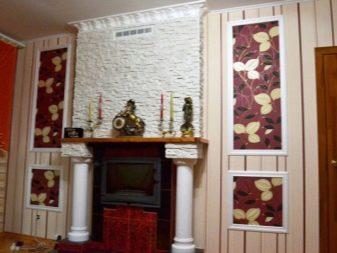Gypsum tile: application features
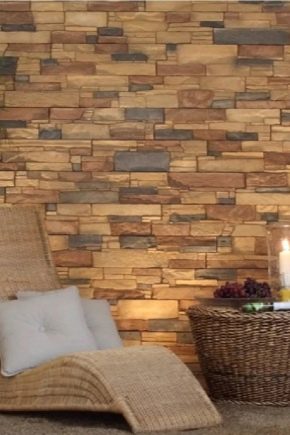
In the process of finishing work, many prefer gypsum tiles. This material stands out against the background of analogues with an unusual structure, it has a number of features and advantages. Let's consider the main nuances and we will study subtleties of application.
Special features
Gypsum cement tile is a building material for interior walls and ceilings. Today this material is widely used in the decoration of the walls of private houses, apartments, office premises, exhibition halls. This is an interior decoration of the walls, less ceiling. You can use it exclusively for interior work.
This material is presented in the modern construction market in the form of a decorative stone, as well as rectangular and square tiles with a relief pattern.
It is based on gypsum - a cheap building material that is environmentally friendly, due to which the gypsum tile is harmless to health.
The convenience of the material is the possibility of preparing it with your own hands, so that this finish can be made in any form for individual requests. This allows you to significantly save money on finishing work, as well as create a unique facing stone that has no analogues. This criterion allows you to finish the interior of the room in different stylistic directions of design.
Composition
Decorative plaster tile material is composed of sand, gypsum, water, as well as modifiers and surface-active components. It is somewhat similar to aerated concrete, which is a type of cellular concrete.
In such a material The main components are cement, quartz sand, lime, aluminum powder and water.. Due to the modifiers, the quality characteristics of the gypsum cladding are quite high: afterdrying glue composition, it becomes strong and durable. Before facing it is subject to crumbling and chipping.
Dimensions
The parameters of gypsum tiles depend on the type of material and its design. It can be represented in the form of individual rectangular bricks (narrow, wide), as well as blocks with a relief, on which several bricks or stones are applied.
This feature determines the appearance: the parameters can be 28 x 6, 29 x 6.5, 38 x 9.5, 19 x 5, 19 x 9.5 cm. The relief fragments for stone are 21 x 10, 27 x 10 cm. Their companions (corner blanks) they are distinguished by the presence of a side face with a length of 7 and 12.5 cm.
Colors and design
The base color of gypsum tile is white. However, today the palette of this facing is more diverse. On sale you can find varieties in milk, beige, sand, light gray shades. Sometimes the manufacturer to give the tile the effect of versatility makes a smooth transition of tones: fragments can have several related shades (for example, light gray and beige). This technique gives the tile greater realism, equating to natural stones and brickwork. In addition to light colors, it can be gray, brownish and even black.
This tile perfectly conveys the texture of stone and brick. In addition to the design under the brick and stone, such a finish can be a plate with a smooth surface and ornament. In this case, the drawing depends on the forms in which the tile is poured. More often it is geometry, simple leaves, lace monograms.
Such materials perfectly replace the headliner, giving it a special elegance.
Advantages and disadvantages
Gypsum tile has a lot of advantages. It is distinguished by its low weight, which makes it easy to replace the laying of stone or brick, which significantly reduces the area of the room in case of a choice for facing accent zones. Through the use of this material there is no need for additional strengthening of the walls. For this reason, it can even be laid on primer-treated drywall.
Gypsum tile is easy to work: you can lay it yourself, without the help of professionals. Often, the finished result looks professional, as if the work was done by a famous designer. In the process of work there is no significant effort: the tile fits perfectly with the prepared base.
If you choose a relief type, there is no need to equate the joints: they simply will not be visible.
Due to the method of manufacturing gypsum tile has the same thickness (with the exception of varieties with multi-level relief). When laying the finish with the texture of a stone or brick there is no need to fit each piece to the desired thickness: a sufficiently prepared base and a uniform layer of glue. Due to the vapor permeability of the wall after finishing, they will be able to breathe, therefore the appearance of mold and mildew is excluded.. This material is able to absorb excess moisture, with dryness, it gives it back into the air.
After laying the surface becomes durable. The material is durable, as it eliminates the possibility of repair for at least 10 years.
All this time, if you try to avoid significant mechanical damage, the look of the facing will be presentable: even the color will not change. This material is fireproof.
With a lot of positive properties, the gypsum tile has several drawbacks. It is completely unstable to moisture.. For this reason, such lining is excluded for the decoration of the walls of a bathroom, basement, unglazed balcony or loggia. This does not allow water to be used to clean the surface, as it can cause the material to gradually wear off, changing the texture of the relief.
Gypsum tile is afraid of temperature drop. If, during the production process, the trademark has not provided for a special protective layer, this facing should not be laid near the heating pipes: the tile may crumble.
If there is no thermal protection layer, the finish of the fireplace protrusion is excluded. It is undesirable to use this tile on the street. There, it quickly loses its appeal and collapses during the year. The facade she trimmed would quickly require dismantling.
How to choose?
That the choice of a plaster tile was successful, factors are considered, beginning from characteristics and finishing the choice of a shade.
The finishing place matters: for the hall, for the hallway, practical material should be used, which is reflected in the choice of color. Here brownish or grayish tones of material and average size are preferable.. The best option will be with several shades.
If the tiles are taken to accentuate the arch, you can start from the place of lining: from the hallway, the corridor is better to choose a tone for wood or sand. If this material decorates the arch from the living room, it is better to choose a lighter tone (milky, cream, white).
For the hall, you can use the options of white and beige. No less interesting is the tone of light oak wenge: today it is in the center of attention of designers.
When choosing a gypsum tile for interior decoration of walls, preference is given to a manufacturer with a good reputation, confirmed by reviews of real buyers. Need to take into account the size and style. The size is selected in accordance with the parameters of the room: the larger it is, the larger the fragments and drawing. The style is subject to certain nuances: the relief with brick and stone is successful in modern interiors, the decoration of stucco and symmetrical forms are inherent in the classics.
When buying, pay attention to the lot number, opening each box of tiles. Inspect the corners, chips, compare color. If necessary, check the length of the side faces: then cut it will not work.
It is necessary to take care of quality packaging to bring home the material without marriage. If the design is designed decorative lighting of the finishing plane, choose a small thickness, otherwise this fact will make fixing fixtures difficult.
Styling methods
Laying decorative plaster tiles is carried out in two ways:
- bricked (or with a shift checkerboard);
- classical reception (with the formation of crosshairs).
The choice of the method is subject to the shape and size of the cladding material. If bricks-clinkers are used in the work, they are tried to be glued to form joints. When imitation of a stone is necessary, try to avoid seams at all. At the end of laying with this method, possible gaps are covered with a special cement mortar to match the tile itself. This allows minimizing the visibility of the joints, as the solidity of the wall surface is needed.
If the work is based on finishing fragments of different sizes with multi-level relief of the faces, gluing resembles a mosaic assembly. In this case wall tile before laying laid on the floor to understand how best to combine parts with a minimum of joints. This method is a hard work in which do not adhere to the alignment of the side faces.
. If the material protrudes beyond the accented area, it is trimmed with a grinder (due to the large thickness, this cannot be done with a regular tile cutter).
Independent production
In home production of gypsum tiles, it is worth considering the weight, dimensions of each fragment, its geometric shape, the number of tiles and the characteristics of the room. The manufacturing process is simple: you will need molds, gypsum, construction mixer, slaked lime. If color tiles are planned, add color to the mix.
If you want to make a special painting, you can do it at the very end of the process, which includes 3 steps:
- pouring the solution;
- drying;
- painting
Take 6 parts of gypsum, 1 part lime, pour water (1: 7 with respect to lime). The consistency of the composition should resemble sour cream, you can stir using the construction mixer. The mixture is stirred until a uniform structure is obtained and poured into molds. Before that the forms are moistened with water, diluted with soap, so that later the stone would be easier to remove. It is important to ensure that the molds are located on a flat surface.
When pouring, check that there are no air bubbles in the composition. In the absence of the vibrating table, the forms are shaken several times: this saves the material being poured from the bubbles.. Grasping occurs during the day: the forms do not touch, leaving them in a dry room.After a day they are taken out. This should be done carefully: this tile is quite fragile.
If necessary, it is painted using water-soluble pigments for paint. To speed up the work, you can use a spray gun, staining evenly, avoiding shade of color. Sometimes, instead of lime, use a finishing putty.
Shape should be shallow. For a brick, a thickness of 0.5 to 1 cm is sufficient; for a slate, a thickness of no more than 1 to 2.5 cm is sufficient. After painting, the surface can be treated with acrylic varnish. For uniform paint it is worth applying acrylic twice.
Care Tips
From time to time, dust accumulates on the surface of the gypsum tile. Pollution is not excluded, which outwardly makes the look untidy. The need for care coincides with the final stage of finishing work. Mechanical damage immediately after finishing is not allowed until the glue layer has dried. Gypsum material cannot be treated with aqueous solutions.: dust is removed with a semi-dry cloth. You can attach it to a brush with stiff bristles: brushing with your hands can cause injury.
The use of a vacuum cleaner is unacceptable: this may cause chipping.If during operation the fragment has left the base or the die has burst, they are replaced.
In order to avoid contamination, you should regularly wipe the surface with a dry, clean cloth. If it is poorly washed, there will be stains on the surface, which will be difficult to remove.
Features of design
This type of finish is quite specific. In order for a gypsum tile to look stylish, it should not be much: the abundance leads to the fact that the texture loses its expressiveness. It is preferable to mark the material with one plane or a certain accent, rather than facing all the walls.
It is worth starting from the place: if it is a living room, you can accent the wall near the dining or video zone. If the decoration is designed to highlight the chimney space, you can arrange the plaster tile or the fireplace ledge itself, or the wall on which it is located.
Pasting two walls is undesirable, even if the material is particularly liked: it will deprive the organization of the space, upset the balance of the style. This decoration is not carried out in several rooms of the dwelling: one accent is enough.
If the decor is chosen for finishing the hallway of an apartment or house, it is worth using it partially, for example, depicting a torn stone (partial laying). This technology is the advantage of gypsum tiles: if required by the design, the application can be a ladder or abstract gluing. In this case, the fragments have a long side parallel to the floor.
If you need to lay around the door, the bricks are perpendicular to the opening. If they decorate the lower edges of adjacent walls, emphasizing the design in ethnic style, the fragments are laid parallel with the shift.
Successful examples and options
To be able to evaluate the beautiful interior decoration of gypsum tiles, you can pay attention to the examples of photo galleries.
- The finishing of the gypsum tiles in the open-plan space looks stylish: the accent wall and the selection of the cooking zone do not overload the interior.
- If you want something special, you can lay one wall, supporting an interesting material texture, making it a decor in the form of dishes on the wall.
- Accentuation of the protrusion is a stylish solution: you can lay out a video zone with a fake stone with plaster tiles, separating it from the cooking space.
- If the material has thermal protection, and you want to emphasize the fireplace area, you can perform stacking under a tattered brick: this decor is the focus of design today.
- If the decoration is conceived in the living room, it is worthwhile to beat the uniqueness of the material through partial styling, decorating it on two sides of the sofa, leaving a place in the center for stylish accents.
- It is possible to beat the difficulties of fixing pictures on the wall by means of partial lining: it is worth laying near the location of the picture, having installed an LED lamp for effective illumination. For complete harmony, it is worth repeating the pattern of decoration under the picture.
- Complicated and a bit pompous reception, not without harmony: a small area above the fireplace looks unusual.
For information on how to make artificial stone from gypsum, see the following video
